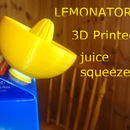Introduction: Bring Your Burnt LED Back to Life!
When I am on a budget... I am able to ressurect my burnt LEDs to reuse them again ;)
Recently my dad used 12V cordless drill battery to kill two of my 3W high power LEDs. Of course he bought me new ones, but without the heatsink... So I took my soldering iron and tried to desolder burnt LED to reuse heatsink... but apparently they were glued onto the heatsink with thermoconductive glue so I was unable to desolder them. I took screwdriver and tried to pry the LED. I was only able to break the outter plastic shell. Then I discovered that I can make it shine again!
Then I saw that I can make the LED to shine again, even with different colour (originally it was cold white)
If you want to know what I saw and how to make burnt LED to shine again (and with different colour!) go on to the next step!
You will need:
- Dead High power LED
- 3,7V battery
- two pins
- soldering iron
- and maybe a flat headed screwdriver to take apart the LED
Step 1: Disassembly the LED
When I was trying to desolder LED from its heatsink I encountered a problem, and accidentaly broken the plastic shell covering the light emmiting element. So I took apart The second burnt LED, this time carefully.
The Clear lens part is made out of two separate materials. Outter shell is made out of clear hard plastic, inner of the lens is made out of rubbery clear material wchich I can't recognise, underneath thwe lens there is Yellow material and finally there is a ligdt emmiting element in form of tiny square.
When you burn your LED you actually do not make damage to the light emmiting element. You just burning that tiny wires that you can see on the photos.
Maybe you watched the "MAKE presents:" episode about LEDs when Collin Cunningham explains how Light Emmiting Diode works. He hook up one wire to the Silicon carbide crystal an he was looking for the spot that after tuching it with second wire gives light.
Basically we are going to do the same...
Step 2: Lightining Up the Dead LED!
So, I soldered two pins to the wires, and soldered them to the battery positive and negative leads.
During my research about LEDs I found that The material used in this diode seems to be Gallium nitride, commonly used in LEDs since 1990s it is more effective than Silicon carbide, and gives a lot more light. Using Galium nitride combined with Indium or Aluminium in LEDs we can achieve different colours from red to ultra violet, if you have Blu-ray in your home you also have Gallium nitride based laser that reads your Blu-ray disc ;)
Now the fun part.
Start touching the square element with pins. Hopefully you will see strong BLUE light... Wait... BLUE?! Isn't the LED White?! It turns out that the white color is achieved by using the yellow material mentioned before. If you know what can it be, post it in the comment so we all can learn something new!
Now what?
It can be used in different ways ;) You can 3D print an enclosure that can hold pins still touching the surface of the light emmiting element and use it as a fancy recycled LED. Personally I am thinking about closing it under glass and make it shine ;) It can also be used for educational purposes to show how the LED is working.
There are a lot of possibilities Everything is up to you ;)
Thank you for reading,
this instructable takes part in the contest so, every vote is important!
Seee you in next instructable!

Participated in the
On a Budget Contest

Participated in the
Explore Science Contest

Participated in the
Burn It! Contest













